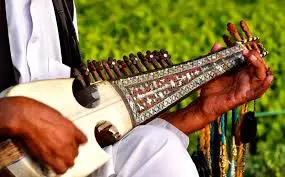Kashmir is a region known for its breathtaking landscapes and rich cultural heritage and has a long-standing tradition of music that reflects its diverse history and influences. Musical instruments in Kashmir are integral to its cultural fabric, with many being unique to the region. These instruments are often used in traditional folk music, Sufi songs and classical performances.
Traditional Instruments of Kashmir:-The Rabab is one of the oldest string instruments played in Kashmir. It has a rich, resonant tone and is typically used in folk and classical music. It is made from a hollowed-out piece of wood, and its body is covered with animal skin. The strings are plucked with a plectrum to produce deep, soulful melodies. The Rabab is deeply connected to Kashmiri Sufi music and is often used in spiritual and devotional performances. The Santoor is a trapezoid-shaped hammered dulcimer, believed to have originated in Persia but adapted and perfected in Kashmir. It is played with lightweight mallets called “mezcal”, and its 100-string layout produces a distinctively melodious and vibrant sound. The Santoor is closely associated with classical music in Kashmir, especially in the context of Sufiana Mausiqi (Sufi music), a genre of Kashmiri classical music.
The Sarangi, a bowed string instrument, has a prominent place in Kashmiri music. It is known for its ability to mimic the human voice, making it ideal for accompanying vocalists. It has three main strings and up to 36 sympathetic strings, giving it a rich tonal texture. The Sarangi is widely used in folk music, religious songs and classical compositions across Kashmir.The Tumbaknari is a simple, hand-played percussion instrument made from baked clay and covered with animal skin. It is shaped like a goblet and is popular in Kashmiri folk music, especially during wedding ceremonies and festive occasions. The Tumbaknari is an essential element of traditional women’s songs (Wanvun), providing rhythmic support to the singers.
Noet is a unique percussion instrument resembling a kettle drum and is used in traditional Kashmiri folk music. It is usually played in pairs and produces a deep, thunderous sound. The Noet is often played in local festivals and during performances of BhandPather, a traditional Kashmiri theatre form that combines drama, dance and music. Another percussion instrument, the Nagara, consists of two drums, one large and the other small. They are played with sticks and are used to create dynamic rhythms in both religious and secular contexts. The Nagara has been a part of Kashmiri music for centuries, often played during festivals, weddings and processions.
The Saz-e-Kashmir, or Kashmiri lute, is a long-necked string instrument that bears similarities to the sitar and is used in classical and folk music. ItIt has a mellow and soothing sound, making it a favourite among Sufi music circles in the region.Music in Kashmir is intertwined with its spiritual and cultural life. Instruments like the Rabab, Santoor and Sarangi are not only used for entertainment but also play a significant role in spiritual and religious gatherings. Sufiana Mausiqi, the classical Sufi music of Kashmir, is deeply connected to the region’s Islamic mysticism and involves the use of these instruments to convey profound spiritual messages.
Folk music also plays a vital role in Kashmir’s social fabric. Instruments like the Tumbaknari and Noet are crucial during social celebrations, where they accompany traditional dances and songs. These performances are often passed down through generations, preserving Kashmir’s unique musical identity.
The musical instruments of Kashmir, from the resonant strings of the Santoor to the rhythmic beats of the Tumbaknari, reflect the region’s rich cultural heritage. Each instrument tells a story of the land’s history, spirituality and community life. Whether in the context of folk celebrations or classical performances, these instruments continue to shape the soundscape of Kashmir, making its music both timeless and transcendent.


